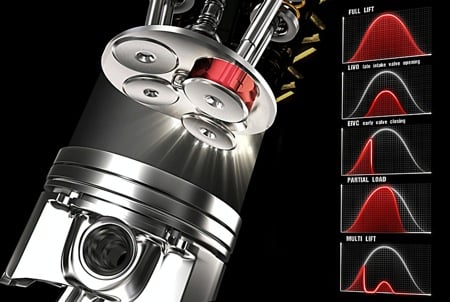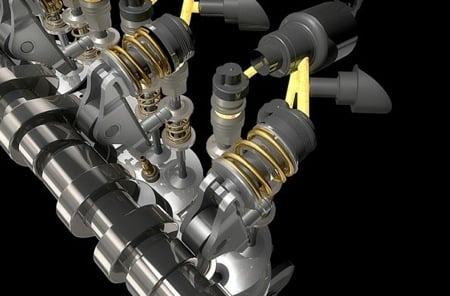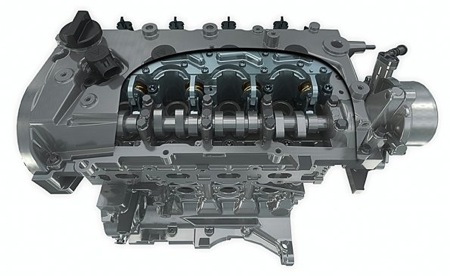
Fiat has revealed a new engine technology called the MultiAir technology which significantly reduces emissions, while improving fuel economy and power delivery. This rather complicated electro-hydraulic variable valve actuation technology is implemented to the intake system. A piston is connected to the intake valve via a hydraulic chamber, which is controlled by a solenoid valve. The movement of this piston is controlled by a mechanical intake camshaft.
When the solenoid valve is closed, the oil in the hydraulic chamber behaves like a solid body and transmits the lift schedule to the intake valves. The lift schedule is imposed by the mechanical intake camshaft. When the solenoid valve is open on the other hand, the hydraulic chamber and the intake valves are de-coupled; the intake valves do not follow the intake camshaft anymore and close under the valve spring action.
The final part of the valve closing stroke is controlled by a dedicated hydraulic brake, to ensure a soft and regular landing phase in any engine operating conditions. Through solenoid valve opening and closing time control, a wide range of optimum intake valve opening schedules can be easily obtained. Continue reading to view more images and to watch a video.

To help improve power, the solenoid valve is always closed and full valve opening is achieved following completely the mechanical camshaft, which is specifically designed to maximize power at high engine speed (long opening time). For low rpm torque, the solenoid valve is opened near the end of the camshaft profile, leading to early intake valve closing. This eliminates unwanted backflow into the manifold and maximizes the air mass trapped in the cylinders.
In engine part-load, the solenoid valve is opened earlier, causing partial valve openings to control the trapped air mass as a function of the required torque. Alternatively the intake valves can be partially opened by closing the solenoid valve once the mechanical camshaft action has already started. In this case the air stream into the cylinder is faster and results in higher in-cylinder turbulence.

The last two actuation modes can be combined in the same intake stroke, generating a so-called Multilift mode that enhances turbulence and combustion rate at very low loads. To help you understand this very complicated system, there is a video to assist you. Overall, benefits include; 10% increase in power, 15% improvement in low rpm torque, 10% reduction in fuel consumption and emissions output for naturally aspirated engines, 25% improvement in fuel efficiency for turbocharged engines and between 40% – 60% reduction in emissions output during cold starts and warm up.
This new technology can also be adapted to all types of internal combustion engines including diesel. Fiat will first offer the MultiAir technology with the 16-valve 1.4 litre engine family, in both naturally aspirated and turbocharged forms. The first vehicle to carry the system would be the Alfa Romeo MiTo by end of this year.
VIDEO: Fiat Multi-Air
[zenphotopress number=99 album=177]
Looking to sell your car? Sell it with Carro.


Ya, i m the first one to post
Hmm… It almost like BMW or Toyota new valvematic engine which control the intake valve by electronic.
Now it is only in intake valve, but i think it can be implemented on the exhaust valve also. By using this kind of technology, i think the engine can be tune from a economy engine into a high rev engine by just adjusting the ECU which control the valve lift! Wow.. i can see a lot of tuning opportunities from this engine..
basically its a great idea, 1 cam shaft is needed only, so conventional vvt tech can be used on exhaust cam if they want2, while intake valves r controlled by hydrolic that regulates thru the exhaust cam.
just not sure about the additional weight(after all, a cam is lighter than that mechanism) vs. improved power output justify the advancement. there r other ways to reduce emission tho, perhaps water injection + light turbo boost to achive similar result?
Toyota also has VVT-iE – http://en.wikipedia.org/wiki/VVT-iE
[quote comment="219102"]Toyota also has VVT-iE – http://en.wikipedia.org/wiki/VVT-iE[/quote]
yeah, tats their recent year's development, but they only use hydrolic on exhaust valve, electric motor on intake, which is different from fiat's. fiat's still have conventional exhaust cam mechanism, but hydrolic for intake
i sense that the day that individual valve can be controlled individually is the future .
[quote comment="219191"]i sense that the day that individual valve can be controlled individually is the future .[/quote]
Fully independent system is still in testing as its not reliable enough for now.
What's the car inside the video?
Nice innovation. KUDOS.
Whoa, brilliant idea from Fiat. Truly go green…
Hey wondering rite, is Fiat making alot of money? I thought they were in trouble or something, can still come out with something like this?
if i can translate from what i saw from the video,
the system require normal camshaft just to give mechanical pulse to the valve reaction but on the middle of the reaction chain there is an interuption or manipulation of hydrolic pressure mechanism(reduce or increase or regulating its presure valve) which ultimately controlled the valve lift and duration.
and what the most unique about this feature is the alteration of valve DURATION which is really flexible in every manner ,even 2 event can pulsed at one time, it is a matter of reducing the hydraulic pressure in the middle of the event and close it back quickly to regain the pressure for another second lift.
so far a fine tuning of intake valve duration cant be done by other technology i think. (correct me)
this will further creating more efficient engine,
and another different compared to vvt, if vvt early opening it will have to early closing, but with this it can be late openeing but early colsing,
thats mean another parameter of engine breathing is created that will further enhanced the engine efficiency.
im not sure its capable of valvematic capability, it can act in simillar way at least if not batter, but the most important is ,its a new way of how the engine breath contributed by a more fine tune/variable of valve DURATION.
This is a very good implementation of Variable Valve Timing and Lift. Will be a stopgap before we move to camless engine (when it is reliable enough).
Fiat is a big company just like VW, Fiat own Alfa Romeo, Ferrari, Maserati and have a lot of share in some China base company, US Chrysler and if not mistaken TATA also got a bit.. Financially is consider quite strong compare to other struggling auto manufacturer..
Notice there's no throttle valve body. i don't see direct fuel injections.
seems interesting ..
yeah..even if they have financial prob, they cannot afford not to invest in r&d..r&d is a must..
that is why a smaller scale car manufacturer lie p1 cannot survive alone..
let say they only have half of the moneys invested by the big car company for r&d, we can say the smaller car company have to be two times smarter to be able to compete with company like FIAT..haha..other wise, forever company like p1 cannot compete directly or become as big as the others..
fiat again… if i not mistaken they r also the first to implement the vvt technology…
IMO this is the best implementation of the variable valve timing and lift system. with such system, the lift and the timing is very easily adjusted without major modification.
The system should be cheaper (single cam) and the hydraulic system is very flexible.
as an example, the common-rail diesel injection system revolutionize the diesel engine. previously diesel injection uses mechanical system similar to camshaft. such system only permits single injection per cycle. with the common-rail system, multi-injection/cycle is possible for the first time and this makes diesel engine quiet, powerful, and clean.
after seeing this, other systems from toyota, honda, BMW, Nissan, etcs…. they are so outdated!
[quote comment="219447"]fiat again… if i not mistaken they r also the first to implement the vvt technology…[/quote]
Yeah! And not only that. They are also the father of modern Common-rail direct injection but sell the technology to Robert Bosch shortly thereafter because they was in a bad financial situation.
[quote comment="219580"][quote comment="219447"]fiat again… if i not mistaken they r also the first to implement the vvt technology…[/quote]
Yeah! And not only that. They are also the father of modern Common-rail direct injection but sell the technology to Robert Bosch shortly thereafter because they was in a bad financial situation.[/quote]
yeah..
let us pray FIAT merge with p1!!!!
i am mechanic i wet to no more i need help , from your seed please . thank you